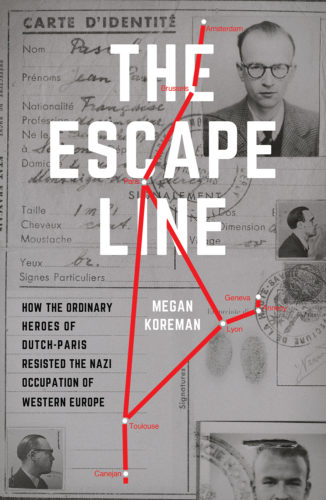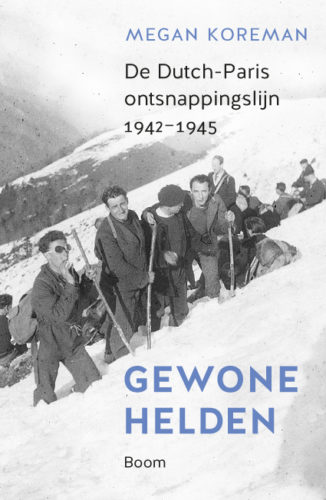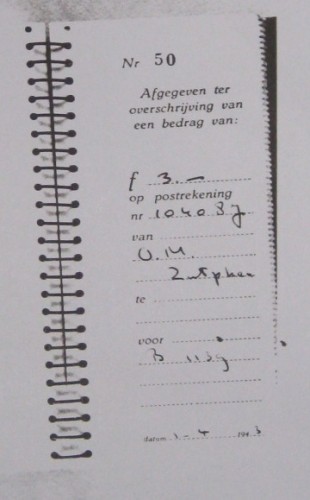Searching for the Dutch-Paris Escape Line
One of the things that makes history so fascinating is that if ten people see the same event, they will have ten different versions or explanations of that event. This is especially true of a catastrophic event such as arrest during the second world war, which was often only the prelude to torture, the unmitigated misery of the concentration camps, and death. So the documents on Dutch-Paris are full of speculations about who or what caused an arrest.
But the problem is that they are all just speculations. No one was in a position to know all the facts. Take the example of two Americans.
First we have our B-17 navigator who was arrested in Brussels on 28 February 1944 and spent his 21st birthday in a Gestapo cell. He and the other nine Allied aviators who were arrested with him and then shipped to Stalag Luft III have always figured that they were arrested because of the betrayal of the “Pole” who wasn’t arrested with them although, logically, he should have been.
Second, we have an American 2nd lieutenant who narrowly escaped arrest Read the rest of this entry »
- 0 Comments
- Tags: Allied airmen, arrests, Belgium, France
When he was still 20 years old, R.F. Anderson took off in a B-17 named “Martha” to bomb Brunswick, Germany. The German air defenses disabled the plane but the pilot and Anderson, as the navigator, managed to nurse it far enough westward that they could bail out over the Netherlands, jumping 500 feet into a soft, sandy carrot field. The farmer, who had already returned from Mass, saw him and hid him in the barn. The Croojman family of Bakel later brought the other four surviving ambulatory crewmen who had been rescued from the German search to their home, where they sheltered and fed them for several days.
Mr Anderson has never forgotten the courage and generosity of the Croojman family, nor of any of the other Dutch people who helped him even if he never learned their names. In his mind, they are the true heroes.
After a few days at the Croojmans’, the Americans were put onto an evasion line that turns out to have been Dutch-Paris. It was all a blur of sheds, attics and barns for them until they were given train tickets and told they were going to Brussels. They had crossed the Dutch border by Maastricht.
In Brussels they rushed first to a hotel near the train station and then to a three story pension that was the line’s HQ. There were rumors that the Paris safehouse had been raided, explaining the high number of aviators at 19, rue Franklin. There were nine Americans, a New Zealander and a man purporting to be a Pole. The aviators were amazed that the Belgian landlady managed to feed them all and suspicious of the Pole. He kept going out for walks.
Early in the morning of 28 February 1944, loud noises woke up the aviators. A large man burst into Anderson’s room, stuck a gun in his face, and demanded to know where his companion was. Anderson said he was alone, but his roommate revealed himself by falling through the floor of the armoire. The aviators were lined up in the garden and counted. Ten. No Pole.
Taken to Gestapo headquarters, Anderson was beaten while questioned about a new device in the B-17. He’s still not sure why. He was even put in solitary confinement, where he spent his twenty-first birthday. Eventually he was moved to the local prison with the others. The guards lifted the tedium one day by promising a special treat. The next day they presented the treat as roast squab, but it had four legs and a tail and Anderson wasn’t that hungry yet.
Eventually the aviators were turned over to the Luftwaffe and moved to Stalag Luft III. The six young Dutchmen arrested at the rue Franklin were kept in the military prison in Brussels until the liberation in September 1944. The Belgian landlady was deported to Ravensbruck, where she perished in January 1945.
Thanks to the precautions of anonymity among the Dutch helpers, the German investigation of Dutch-Paris did not reach as far as that carrot field near Bakel, nor the Croojmans’ farm.
Much to be Thankful for…
Studying the Second World War gives one a perspective that makes the Thanksgiving season all the more meaningful.
During the war, millions of men, women and children were displaced from their homes as soldiers, refugees, (slave) laborers or prisoners. Most did not leave forwarding addresses. So let us be grateful that we know where our loved ones are.
During the war all mail and news was censored, if not completely stopped. The Dutch Queen in London had no way of knowing what was happening amongst her people other than by risky and slow clandestine paths. Prisoners sentenced to “nacht und nebel” (NN, night and fog) were deliberately isolated to spread uncertainty and fear among their compatriots. So let us be grateful for the free flow of communication.
During the war people starved to death, and not just in the concentration and extermination camps or the occupier-orchestrated famines in the Netherlands and Greece. People starved to death in Paris. So let us be grateful for the abundance on our tables.
During the war death and destruction rained down from the skies. By the end the survivors in Berlin were hiding from the rampaging Red Army in caves dug out of rubble without electricity or clean water or any public service whatsoever. So let us be grateful that the skies over North America and Europe are peaceful.
And let us guard that peace zealously and work to extend it to all the people of the world.
Better to be Caught as a Smuggler
One of the difficulties with illegal border crossing during the war was that you had to carry two sets of ID with you, one for each side. It was incriminating, to say the least, to be caught with both Dutch and Belgian papers at the border.
Different people had different approaches to the problem. You could, of course, carry only one set of papers and spin a good yarn about why you were on the other side of the border. This worked best if you had family on both sides and could reasonably claim to have innocent reasons to be visiting relatives.
You could also carry some minor contraband item, such as a pound of butter, that would distract a customs agent from further investigations. There might be some unpleasantness Read the rest of this entry »
- 0 Comments
- Tags: aliases, Border Crossings
What to do about the Parents?
It wasn’t just their children whom resisters had to worry about: their entire families were in danger of German retribution. But the calculus of risk is different when it involves adults. Some chose to protect their parents by excluding them; others to involve them.
For instance, one young Dutchman went so far as to sign the German loyalty oath for university students in order not to bring any attention to his Jewish father. But he didn’t let it stop him from all sorts of illegal activities, including bringing people over the Dutch-Belgian border.
There were other families, however, who worked together in the good fight. In Brussels in particular, most of the well-established businessmen in the line had sons in their early twenties, in other words just the right age to be taken for compulsory labor or want to go to England to fight with the Allies. The fathers gave money to the cause or sheltered fugitives while the sons smuggled microfilms and downed Allied aviators.
Similarly, a young French woman who escorted aviators and other fugitives between Paris and Toulouse was arrested with her mother at the family home in June 1944. It seems that her parents were active in a different, French network and possibly also Dutch-Paris. They all survived the camps.
It did not always turn out so well. In 1943 the Gestapo arrested a man in Amsterdam for helping Jews. A few months later, they found his daughter in Paris, where she was working as a courier for Dutch-Paris. They made her watch unknown men being tortured. They subjected her to a water torture. And they told her that she alone could save her father: if she talked, they’d release him. She talked. They released her father but then promptly rearrested him and deported him to a concentration camp where he died. She herself survived Ravensbrück.
As a result of that woman’s revelations, the Germans arrested John Henry Weidner’s sister Gabrielle while she was at church and offered to release her in exchange for Weidner himself. Forced to choose between his sister and the entire network, he did not turn himself in. Gabrielle died in Ravensbrück, a fact which preyed on Weidner for the rest of his long life.
- 0 Comments
- Tags: arrests, John Henry Weidner
Hide the Children
As if having the Gestapo on your trail weren’t enough, the men and women of the Resistance also had to worry that the Germans had little scruple about using their families against them.
Resisters took what precautions they could, of course. Perhaps the most important reason to use an alias was not to hide yourself, but to hide your family. Some people went further and actually hid their families.
John Henry Weidner smuggled the children of at least three resisters into Switzerland so they couldn’t be used as hostages by the Germans. He himself carried the small son of a prominent French resister through the snow into Switzerland around the same time that he also escorted the children of one of the few women to lead a French Resistance network out of occupied territory. He also took the daughters of a high-ranking Dutch diplomat who was in a Vichy prison into Switzerland when it became too dangerous for them Read the rest of this entry »
- 0 Comments
- Tags: aliases, arrests, Switzerland
In Service of Humanity
Dutch-Paris defies easy categorization even within the extraordinary ranks of Resistance organizations. It was not a group of patriots intent on freeing their home, nor was it a group dedicated to helping their own co-religionists. It was not even a purely Dutch network despite the missions it accepted from the Dutch government-in-exile.
True, most of the people who worked on the line or came through it as fugitives were Dutch. But given the pre-war social pillarization of the Netherlands in which Catholics associated with Catholics and Calvinists with Calvinists, Dutch-Paris represented a striking range of Dutch society. There was a Dutch Catholic priest serving in Toulouse and a Dutch Reformed pastor in Brussels. John Henry Weidner himself was the devout son of a Dutch Seventh Day Adventist preacher. There was a Dutch engineer running a shipyard in Belgium and several Dutch farmers with land in France. There were Dutch nurses, university students, soldiers, widows rich and poor, secretaries, butchers, diplomats and aristocrats.
The fugitives whom Dutch-Paris helped escape from the Nazis were equally mixed. There were singers, writers, students, politicians and housewives. Many were Jewish but certainly not all. A minister and his wife who had run afoul of the Gestapo Read the rest of this entry »
- 0 Comments
- Tags: Belgium, France, Jews, The Netherlands
Somethings You Must Not Forget
While some resisters struggled to forget the war, others came to feel that they had a duty to remember it publicly. This seems to have been especially true among survivors of the concentration camps.
Such was the case with a Dutch woman named Anika who was a student at the Sorbonne when the war started. When the Germans invaded, she fled Paris with her good friend Anne-Marie [see “Everything I Saw in the Camp…” of July 20, 2009]. Later, they returned together and started helping others to escape from the Germans. Anika and Anne-Marie organized hiding places, food, clothing, and false papers for other Dutch people on the run and for Allied airmen. They also did the dangerous work Read the rest of this entry »
- 0 Comments
- Tags: arrests, concentration camps, France, women
Somethings You’d Rather Forget
My research on Dutch-Paris constantly reminds me that wars don’t end when the fighting stops. This is most obvious in the cases of those resisters who survived the concentration camps but then died young after years of broken health. But even those who escaped deportation and made successful careers for themselves never quite got over the war.
Take the case of a Dutchman we’ll call De Jong. Like many other students, he left his university in 1942 when the Germans required a loyalty oath (to themselves of course). In August 1943 he became a regular courier for the Swiss Way between Amsterdam and Brussels. That meant that he smuggled microfilms over the border then turned them over to another Dutch-Paris courier to be taken on to Switzerland in exchange for microfilms heading back to the Resistance in Amsterdam. After the “roll-up” [arrests] of Dutch-Paris in February 1944, De Jong took over responsibility for the “mail” in Brussels until the liberation in September ’44.
Eventually, he finished his studies and had a successful career in the Dutch government. But the war could still ambush him Read the rest of this entry »
- 0 Comments
- Tags: arrests
Five Reasons to Use Enemy Papers
According to a written note sent to the Dutch military attaché in Bern by John Henry Weidner and one of his top lieutenants, there were five good reasons for fugitives to use false German documents while en route to Spain or Switzerland.
1 – So many thousands of Dutch people actually did work for German organizations in France that it would be hard to verify whether the fugitive did or not. [Quite understandably, Dutch men subject to compulsory labor preferred to build fortifications in France for the Organization Todt than work in Germany itself.]
2 – The fugitive didn’t need to speak German or French because according to his papers he was a Dutchman in German service.
3 – The fugitive didn’t need to worry about document controls by Germans in the trains Read the rest of this entry »


